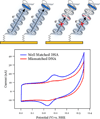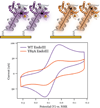DNA Charge Transport: from Chemical Principles to the Cell
- PMID: 26933744
- PMCID: PMC4803044
- DOI: 10.1016/j.chembiol.2015.11.010
DNA Charge Transport: from Chemical Principles to the Cell
Abstract
The DNA double helix has captured the imagination of many, bringing it to the forefront of biological research. DNA has unique features that extend our interest into areas of chemistry, physics, material science, and engineering. Our laboratory has focused on studies of DNA charge transport (CT), wherein charges can efficiently travel long molecular distances through the DNA helix while maintaining an exquisite sensitivity to base pair π-stacking. Because DNA CT chemistry reports on the integrity of the DNA duplex, this property may be exploited to develop electrochemical devices to detect DNA lesions and DNA-binding proteins. Furthermore, studies now indicate that DNA CT may also be used in the cell by, for example, DNA repair proteins, as a cellular diagnostic, in order to scan the genome to localize efficiently to damage sites. In this review, we describe this evolution of DNA CT chemistry from the discovery of fundamental chemical principles to applications in diagnostic strategies and possible roles in biology.
Copyright © 2016 Elsevier Ltd. All rights reserved.
Figures








References
-
- Almirón M, Link AJ, Furlong D, Kolter R. A novel DNA-binding protein with regulatory and protective roles in starved Escherichia coli. Genes Dev. 1992;6:2646–2654. - PubMed
-
- Arkin MR, Stemp ED, Holmlin RE, Barton JK, Hörmann A, Olson EJ, Barbara PF. Rates of DNA-mediated electron transfer between metallointercalators. Science. 1996;273:475–480. - PubMed
-
- Arkin MR, Stemp ED, Pulver SC, Barton JK. Long-range oxidation of guanine by Ru(III) in duplex DNA. Chem. Biol. 1997;4:389–400. - PubMed
Publication types
MeSH terms
Substances
Grants and funding
LinkOut - more resources
Full Text Sources
Other Literature Sources
Research Materials
Miscellaneous

